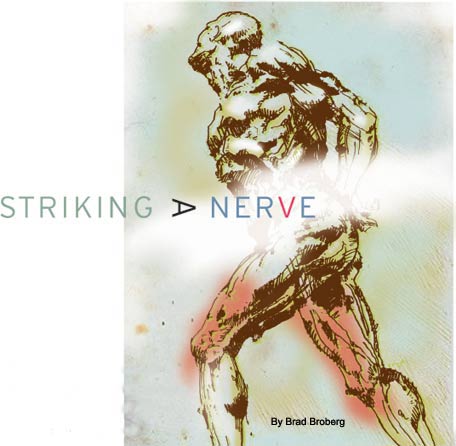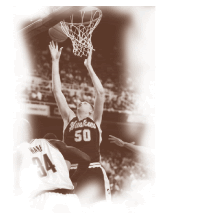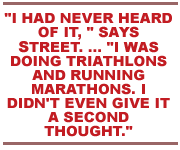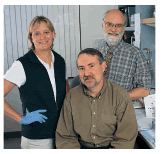

It's Inherited, It's Incurable and It Hits More Than 150,000 Americans Each Year-Yet Most of Us Never Hear of 'CMT' Until It Strikes Close to Home.
Before Thomas Bird can treat Charcot-Marie-Tooth disease (CMT), he usually has to explain it. "People think it's some kind of dental disease and something might be wrong with their teeth," he says.
In reality, CMT is the most common inherited neurological disorder in the U.S., mysteriously robbing approximately 150,000 Americans of strength and sensation in their limbs, hands and feet each year. While not fatal, it is incurable.
Even so, medical geneticists such as Bird, a neurology professor at the University of Washington and a physician at the Veterans Affairs Medical Center, have collected numerous clues that could someday solve the riddle behind the obscure-yet surprisingly prevalent-disorder. "It's not rare," says Bird. "I've literally seen hundreds of people with the disease."
Like most people, Todd MacCulloch, '99 had never heard of Charcot-Marie-Tooth disease-until it hit home. The two-time All-Pac-10 center for the Husky basketball team was coming off his best NBA season ever and starting training camp for the 2002-2003 season with the Philadelphia 76ers when he first noticed signs of what doctors now suspect may be CMT. "It changed the sensation of what I feel in my feet," he says. "They feel tired and bothersome and tingly and kind of numb."
After struggling to continue playing, MacCulloch went to the sidelines in February of 2003 and hasn't suited up since. Even after all this time, MacCulloch says it's still "up in the air" whether he has CMT or another nerve disorder. "Some things fit well, some don't fit at all," he says. "They don't have a good test for the type I'm suspected of having."
In most cases, a family history of CMT is a key piece of evidence. Although his mother shows some signs, MacCulloch says his family otherwise displays no symptoms.

Not knowing for certain whether he has the incurable disease is both a blessing and a curse, says the 28-year-old MacCulloch. "I would feel better [knowing] just because I'd be able to deal with it better," he says. "On the other hand, not knowing gives me a reason to be hopeful that I can be as [healthy] as I was before."
In January, MacCulloch underwent surgery to relieve suspected pressure on nerves in his left foot. He hoped to repeating the surgery on his right foot if the procedure proved successful. As of mid-summer, however, he was looking for another alternative. "There have been no significant improvements, unfortunately," MacCulloch told the Associated Press. "I'm hoping for a miracle, really."
As MacCulloch's case illustrates, CMT is a frustrating disease that continues to keep scientists busy as they chase the mutant genes that cause its unpredictable behavior. While researchers have fingered many of the "good-genes-gone-bad" that trigger various forms of CMT-enabling doctors to make definitive diagnoses-they still don't know why the guilty genes cause the nerves in the legs, feet, arms and hands to degenerate and lead the muscles in those regions to atrophy.
CMT's limitations can range from merely annoying to disabling enough to put a person in a wheelchair. Besides losing strength in some or all of their extremities, patients also may lose sensation. Onset can occur at any age-without any known triggers-and the disease's pattern of inheritance can differ from family to family. "It's very hard to keep track of all of the different forms of it," says Bird.
Treatment options are limited. Doctors generally recommend physical therapy and moderate exercise to maintain as much muscle strength as possible. Leg braces, custom shoes and canes help people compensate. Occasionally, orthopedic surgery provides some improvement.
With his hoop career on hold, MacCulloch, the third leading scorer in Husky basketball history, does what he can to remain ready for a possible return to the NBA. "Maybe I'm too optimistic; I'm still trying to shoot and keep my skills up the best I can," he says. "I can't run or jump, but I'm still around the game."

Like MacCulloch, Valerie Street, a UW assistant professor of otolaryngology, also has CMT, but instead of sidelining her, it motivated her.
Street was 20 when she was initially diagnosed with CMT, but didn't notice any effects for several years. A former triathlete, she has since experienced a "huge lifestyle change." She's lost muscle mass, has poor balance and is vulnerable to stress fractures.
"My feet hurt every day-it's just the extent to which they hurt," says 39-year-old Street. Still, she strives to stay as active as possible to stave off further atrophy. "I've taken up golfing-with a cart," she says. "I do a little cross country skiing and I'm able to walk short distances."
Street was recovering from a series of foot surgeries-triggered by years of running or CMT or a combination of both-when in 1997 she approached Bird and Phillip Chance, a professor of pediatrics and neurology, about joining their ongoing CMT research. Together with the two veteran researchers and several other collaborators, Street went on to publish a study in the January 2003 edition of Neurology (the journal of the American Academy of Neurology) that identified a new genetic link to CMT in a large number of families.
Collaborators since the 1980s, Bird and Chance had long been treating, testing and tracking families with histories of CMT, making important discoveries about the location and nature of some of the genetic abnormalities linked to the disease.

In fact, Bird led a 1980 study that pointed toward the first molecular address for a gene linked to CMT. And in 1992, Chance discovered a variation of CMT that turned out to be a separate disease-hereditary neuropathy pressure palsy.
"For the last 30 or 40 years, a lot of what we've learned about CMT has come from the University of Washington," says Michael Shy, chairman of the Medical Advisory Board of the Charcot-Marie-Tooth Association and a professor of neurology and molecular medicine/genetics at Wayne State University in Michigan. "You have two giants at that institution."
Bird and Chance have been following some famous footsteps-those of renowned French physician Jean Marie Charcot. "Charcot is a very, very prominent name in the history of neurology-one of the fathers of the whole discipline," says Bird.
During the late 19th century, Charcot was in charge of a huge hospital in Paris that housed thousands of people with neurological and psychiatric disorders. Charcot and a colleague, Pierre Marie, took it upon themselves to try to “make sense of who had what,” says Bird.
In the course of their work, Charcot and Marie noticed a number of patients with weakness and atrophy in their hands and feet. The condition was slowly progressive and ran in families. As it turned out, they weren't the only doctors intrigued by the hereditary ailment. In London, Howard Henry Tooth was studying the very same condition.
Working independently and unaware of each other, Charcot-Marie and Tooth reported their findings separately but simultaneously in 1886-a coincidence that spawned the disease's doubly hyphenated name.
Still, for nearly 100 years, scientists viewed CMT as a singular disease. Finally the Mayo Clinic conducted a series of tests in the late 1960s and early 1970s that produced hard evidence of the disease's true-and highly diverse-nature, says Bird.
Using electro-stimulation, doctors measured the speed with which the nerves of CMT patients conducted electricity. "Nerves are similar to wires in the body," says Bird. "That's part of what they do-conduct electricity." The conduction tests found several distinct forms of CMT patients based on the speed with which the current traveled through their nerves. The most prominent variations were labeled CMT-1 (dramatic slowing) and CMT-2 (mild slowing).
Go To: Page 1 | Page 2
Sidebar - Haunted for Five Generations